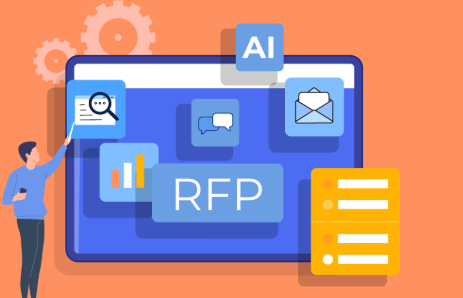7 Key Features to Look for in an AI RFP Tool for Modern Teams
The way businesses respond to RFPs is changing. Traditional methods that involve manual processes and siloed workflows are no longer enough to keep up with today’s high-speed, high-volume RFP demands. Teams that consistently win over 50% of their RFP bids typically submit an average of 175 proposals annually. This shows just how critical speed and accuracy are in today’s competitive bidding environment.
For enterprise-level teams, where accuracy, speed, and collaboration are critical, a next-gen AI RFP tool built for sales and compliance offers the perfect solution. These tools can significantly improve productivity, reduce errors, and streamline decision-making processes, making them indispensable for proposal managers, bid teams, and sales reps.
1. Intelligent Proposal Automation: Streamlining the Process
Automation is one of the most transformative aspects of AI in RFP management. AI tools can automate repetitive tasks, reduce human errors, and speed up the proposal lifecycle. This makes it possible for teams to focus on strategy and creativity rather than mundane tasks.
Template Suggestions
AI tools can analyze past successful proposals and suggest templates tailored to the specific RFP. By using natural language processing (NLP) and machine learning, these tools recommend the best-fit templates that align with the client’s requirements. This capability drastically cuts down the time needed to start writing responses, allowing teams to get started quickly with minimal effort.
Auto-Fill Features
An AI RFP tool can offer smart auto-fill functionality by populating sections of the proposal with previously used content, like standard qualifications, case studies, or product descriptions. This ensures consistency and saves time, particularly for large teams responding to multiple RFPs at once. Teams can quickly make updates and fine-tune the proposal to reflect the unique needs of each client.
2. Collaboration and Real-Time Editing: Enhancing Team Workflows
Collaboration is crucial for proposal teams. With large-scale RFPs requiring input from various departments—such as sales, legal, and engineering—having a tool that supports real-time collaboration is invaluable. High-performing teams that win 51% or more of their RFP bids depend on seamless collaboration tools to maintain accuracy and efficiency throughout the process. AI RFP tools allow multiple team members to work on the same proposal simultaneously, increasing speed and ensuring the accuracy of responses.
Multi-User Editing
Multi-user editing allows sales teams, bid managers, and other stakeholders to work on different sections of the same document without overwriting each other’s work. AI-backed tools ensure that updates are reflected in real time, minimizing miscommunication and allowing seamless collaboration. This feature becomes even more critical when dealing with multiple departments that may be dispersed across various locations.
Commenting and Feedback Tools
AI tools provide enhanced commenting and feedback functionalities, allowing reviewers to add context-based suggestions directly within the proposal. By analyzing previous RFP responses, the AI can also suggest areas that may require additional attention, helping managers ensure that nothing is overlooked. This feature streamlines internal feedback loops, speeds up revisions, and results in a better-quality proposal.
3. Seamless Integration with CRM and Other Tools: Connecting the Ecosystem
The effectiveness of an AI RFP tool is amplified when it integrates with other business systems such as Customer Relationship Management (CRM) software, project management tools, and document storage platforms. Seamless integration minimizes the need for manual data transfers, ensuring that everyone on the team is working with the most up-to-date information.
Read Also: How Startups Use Tech to Disrupt Industries
CRM Integration
AI RFP tools that integrate with CRM systems like Salesforce allow teams to pull client information, past interactions, and deal-specific insights directly into proposals. This ensures the accuracy of the information while personalizing responses to meet the client’s exact needs. The CRM integration also keeps the sales team aligned with customer expectations and proposal details.
Data Syncing with Project Management Tools
Data syncing with tools like Asana or Trello ensures that all team members have access to the same project timelines, tasks, and requirements. AI-backed synchronization removes the need for manual updates, reducing errors caused by data duplication. This ensures that each team member knows exactly what their role is and how their input fits into the larger RFP process.
4. RFP Compliance Assistance: Ensuring High-Quality, Accurate Responses
Compliance is non-negotiable when responding to RFPs. AI tools assist proposal managers in tracking and meeting the exact requirements set forth by the client. These tools can automate the compliance-checking process, minimizing human error and improving the accuracy of responses.
Real-Time Compliance Checking
AI RFP tools can instantly track whether all client requirements are being met, flagging any missing or incomplete sections as soon as the proposal is being worked on. This real-time compliance checking helps ensure that the proposal remains compliant throughout the drafting process, reducing the risk of disqualification due to non-compliance.
Risk Identification
AI can also analyze patterns in previous RFP submissions to highlight potential risks or gaps in the proposal that may jeopardize the chances of winning. Whether it’s identifying ambiguous language or highlighting mismatched sections, AI tools give teams a heads-up before they submit their proposal. This risk identification feature is particularly important for high-stakes, high-value bids where mistakes can be costly.
5. Advanced Analytics and Reporting: Gaining Insights for Future Proposals
One of the biggest advantages of AI tools is their ability to provide actionable insights into the proposal process. By analyzing past submissions, win rates, and client feedback, these tools enable teams to make data-driven decisions that optimize future proposals.
Data-Driven Insights
AI RFP tools track key performance indicators (KPIs) like win rates, proposal quality, and response times. By using this historical data, teams can identify trends that help them refine their approach to future RFPs. For example, the AI might reveal that proposals with certain keywords or case studies have a higher success rate, allowing teams to tailor future responses for better outcomes.
Predictive Analytics
Using predictive analytics, AI can forecast the likelihood of success for a given proposal based on historical data. This can help proposal managers prioritize which RFPs are worth pursuing and allocate resources accordingly. Predictive analytics can also inform decisions about pricing, content, and approach by identifying which strategies have worked best in the past.
6. Customization and Scalability: Tailoring the Tool to Team Needs
Every team has unique requirements based on its size, workflow, and objectives. The best AI RFP tools are highly customizable, enabling teams to configure features and workflows to meet their specific needs. Additionally, scalability is important for growing teams that require a tool that adapts as they expand.
Customizable Features
AI RFP tools can be customized with fields, templates, and workflows that align with your team’s needs. Whether it’s adjusting approval processes or adding custom content blocks, the flexibility offered by AI tools ensures that they can fit seamlessly into existing workflows. This reduces the need for major process overhauls while improving overall efficiency.
Scalability for Growing Teams
As teams grow, their RFP needs become more complex. A scalable AI RFP tool ensures that as the team expands, the tool can handle the increased volume and complexity without sacrificing performance. Whether it’s the addition of more users or handling a higher number of proposals, AI-powered solutions grow alongside the organization, ensuring continued efficiency.
7. Security and Data Privacy: Protecting Sensitive Information
RFP responses contain confidential information, and ensuring that this data remains secure is a top priority. AI tools designed for RFP management come with advanced security features to safeguard sensitive data from breaches and unauthorized access.
AI-Powered Data Encryption
Advanced encryption protocols powered by AI ensure that data is encrypted both in transit and at rest. AI systems can also detect and prevent any unusual activity, further enhancing security. With the ever-increasing risk of cyber threats, having robust security measures is crucial to protecting both client data and proprietary information.
User Authentication and Access Control
AI RFP tools can provide granular user authentication, ensuring that only authorized individuals have access to sensitive proposal information. Role-based access controls (RBAC) allow teams to assign specific permissions, ensuring that each user only sees the information necessary for their role. This tightens security and reduces the likelihood of data leaks or unauthorized modifications.
Conclusion: Choosing the Right AI RFP Tool for Your Team’s Success
When selecting an AI RFP tool, it’s essential to focus on features that align with your team’s specific needs and objectives. Intelligent automation, seamless integration, and compliance tracking are just the beginning—ensure the tool you choose offers strong collaboration, advanced analytics, and robust security. By adopting the right AI RFP tool, modern teams can not only improve their efficiency but also enhance the quality of their proposals, driving success in competitive bidding environments.






